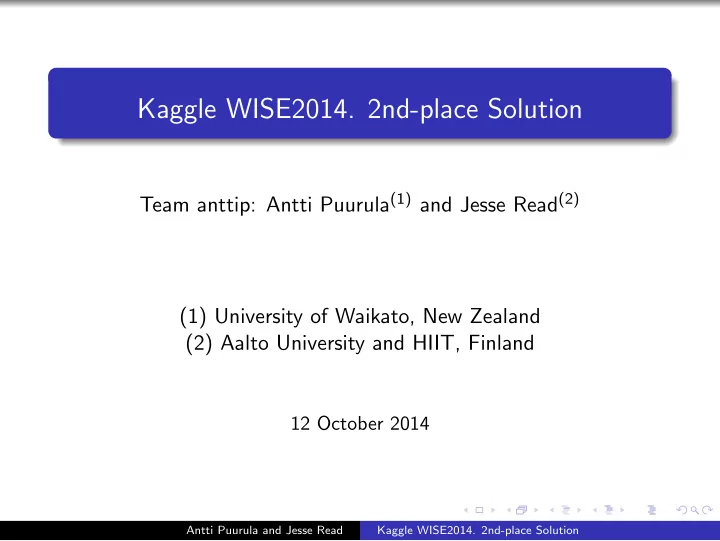

Kaggle WISE2014. 2nd-place Solution Team anttip: Antti Puurula (1) and Jesse Read (2) (1) University of Waikato, New Zealand (2) Aalto University and HIIT, Finland 12 October 2014 Antti Puurula and Jesse Read Kaggle WISE2014. 2nd-place Solution
Overview An ensemble of diversified base-classifiers combined with a variant Feature-Weighted Linear Stacking Features: Word counts, LDA features, word pair features TF-IDF and other optimized transforms applied to some features Base-classifiers: Extensions of MNB and Multinomial Kernel Density models Logistic Regression, SVM, and tree-based classifiers Problem-transformation methods: Binary relevance, classifier chains, and label-powerset based methods (incl. pruned sets and RAkEL) Ensemble: Feature-Weighted Linear Stacking with hill-climbing classifier selection Thresholded label selection from the top label candidates Antti Puurula and Jesse Read Kaggle WISE2014. 2nd-place Solution
WISE2014 weighted counts GibbsLDA word counts word pairs LibLinear MEKA SGMWeka Feature-Weighted Linear Stacking classifier selection thresholded label selection Antti Puurula and Jesse Read Kaggle WISE2014. 2nd-place Solution
Data Segmentation Documents Used as 1—58857 training base classifiers next 5000 5 × 1000 for base-classifier optimization final 5000 ensemble learning set Antti Puurula and Jesse Read Kaggle WISE2014. 2nd-place Solution
Features Original word counts recovered using a reverse TF-IDF search: reverse the IDF and log-transforms, constrain the minimum count of a word to 1, and solve for the missing document length norm variable Topic features with Gibbs LDA++ computed 5 different topic decompositions (ranging from 50—300 topics per document) with parameters and pre-processing choices recommended in the literature Word pair features: use IDF and count thresholds to prune possible pairs, represent each document with pruned word pairs total 6011508 pruned word pairs, mean 227.33 per document Features further transformed with TF-IDFs depending on the classifier Antti Puurula and Jesse Read Kaggle WISE2014. 2nd-place Solution
Problem Transformation Multi-label problem transformation methods binary relevance (BR) classifier chains (CC) label powerset (LP) pruned label poweset (PS) random [pruned] labelsets (i.e., RAkEL+PS) chained random labelsets (i.e., CC+RAkEL) Antti Puurula and Jesse Read Kaggle WISE2014. 2nd-place Solution
Summary of Toolkits Used Base classifiers Toolkit Prob. transform. Features gen., algebraic LP, PS words, word pairs SGMWeka discriminative BR, CC, RAkEL words, LDA LibLinear discriminative RAkEL, PS, CC LDA, words Meka In SGMWeka and LibLinear , base classifiers were optimized using 40x20 Gaussian Random Searches (Puurula 2012) on the 5x1000 development folds. In Meka , parameters for base classifiers were chosen randomly upon each instantiation, from sensible ranges Heavy pruning and small subsets in some cases, particularly for tree-based methods Antti Puurula and Jesse Read Kaggle WISE2014. 2nd-place Solution
SGMWeka Generative (MNB, . . . ) and algebraic (Centroid, . . . ) models Extensions of MNB such as Tied Document Mixture (Puurula & Myang 2013) Hierarchical smoothing with Pitman-Yor Process LM, Jelinek-Mercer Model-based feedback Exclusive training subsets for the ensemble Label powerset methods most scalable in this framework See https://sourceforge.net/projects/sgmweka/ for details. Antti Puurula and Jesse Read Kaggle WISE2014. 2nd-place Solution
LibLinear Discriminative classifiers (SVM, LR) with L1 regularization worked best Words and LDA used (word pairs didn’t work well) Used binary relevance and classifier chains transformations (label powerset methods were not scalable) Also tried: Chained Random Labelsets (CC becomes more scalable this way) Antti Puurula and Jesse Read Kaggle WISE2014. 2nd-place Solution
Meka Meka classifiers ( ≈ 100) with randomly chosen . . . feature space one of the five LDA transforms base classifier (Weka) one of SMO , J48 , SGD . . . and parameters e.g., -C for SMO, pruning for trees problem trans. (Meka) RAkEL-PS, RAkELd-PS , PS, or CC-RAkEL . . . and parameters m sets of k labels, with p , n pruning feature subspace 5 to 80 percent instance subspace 5 to 80 percent also tried with original words feature space, but quite slow See meka.sourceforge.net for details. Antti Puurula and Jesse Read Kaggle WISE2014. 2nd-place Solution
Ensemble: Feature-Weighted Linear Stacking Approximate optimal weights for each instance and classifier using an oracle Predict vote weight of each base-classifier using meta-features: document L0-norm output labelset properties (e.g., frequency in training set) output labelset for neighbouring documents correlation of the labelsets to predictions of other base classifiers Features transformed by ReLU and log-transforms Use a Random Forest for each base classifier and its meta-feature set Antti Puurula and Jesse Read Kaggle WISE2014. 2nd-place Solution
Ensemble: Threshold Selection Sum a score for each label, and Threshold on the maximum score for the document, such that labels with score > 0.5 * max score are selected Antti Puurula and Jesse Read Kaggle WISE2014. 2nd-place Solution
Ensemble: Base-classifier Selection Select base classifiers to optimize ensemble Mean F-score performance Parallelized hill-climbing Tabu-search steps of addition, removal or replacement of a base-classifier random restarts penalization term on the number of base-classifiers (accelerated optimization considerably) Final ensemble: around 50 base-classifiers, from over 200 generated Antti Puurula and Jesse Read Kaggle WISE2014. 2nd-place Solution
Discussion / Lessons Learned Data segmentation is critical, leave the last training set documents for optimization reduces overfitting L1-regularized linear base-classifiers worked best we should have used data weighting and label-dependent parameters Scalability becomes an issue for problem transformation with Weka -based frameworks the Instance class is a bottleneck: attribute space copied many times internally can train base-classifiers one-at-a-time, or use heavy subsampling Ensemble combination saved the day: our base-classifiers scored lower than other teams, but were very diverse Antti Puurula and Jesse Read Kaggle WISE2014. 2nd-place Solution
The End Thank you for your attention. Antti Puurula: http://www.cs.waikato.ac.nz/˜asp12/ Jesse Read: http://users.ics.aalto.fi/jesse/ Antti Puurula and Jesse Read Kaggle WISE2014. 2nd-place Solution
Recommend
More recommend